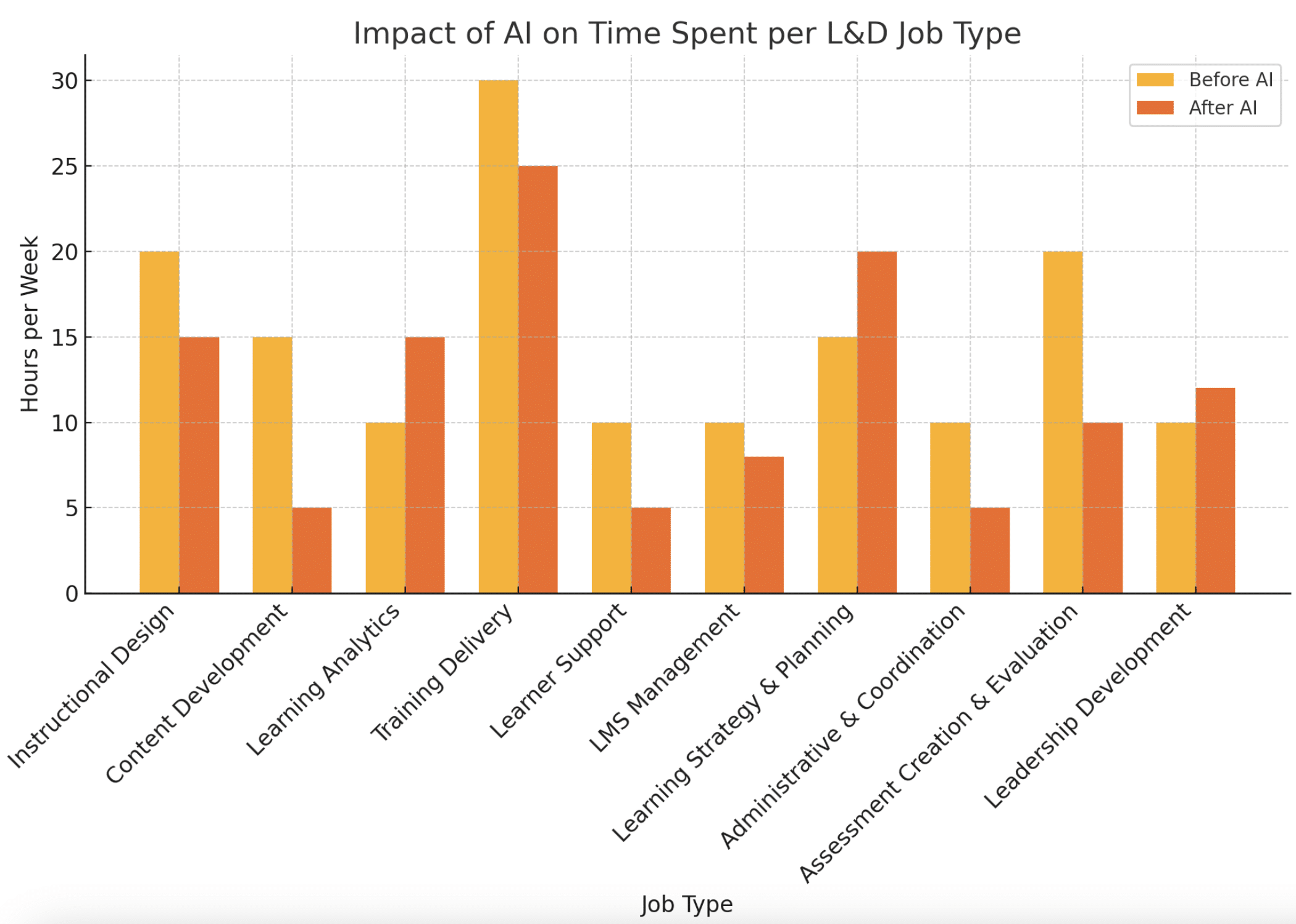How AI is Redefining Roles and Skills in L&D

In the evolving landscape of Learning and Development (L&D), a quiet revolution is underway. It’s not loud or flashy, but it’s powerful. The rise of artificial intelligence, particularly models like ChatGPT, is transforming how L&D professionals work. The question is no longer whether AI will affect L&D, but how. And more importantly, how should L&D professionals adapt?
Imagine a scenario: a large organization relies on its L&D department to design and deliver training, manage an LMS, create content, and measure success through assessments and analytics. Traditionally, these tasks required a significant investment of time, often split between designing learning programs, developing content, providing learner support, and running assessments. Now, with AI in the mix, that time equation is shifting.
Take instructional design, for example. AI can now provide frameworks, templates, and initial drafts for learning materials. Instead of spending 20 hours per week meticulously crafting each course, instructional designers may only need 15 hours to refine what AI has already started. The process becomes about curating rather than creating from scratch. Content development, long a time-consuming task, is reduced even more dramatically. Where once professionals might spend 15 hours per week writing content, they may now spend just 5, with AI generating initial drafts and outlines. The work becomes about fine-tuning, personalizing, and ensuring the tone is right.
Conversely, areas like learning analytics are expanding. AI is providing more data than ever before, but interpreting this data—translating it into actionable insights—requires human intuition and expertise. Time spent in learning analytics will increase, with professionals now needing to focus on what the data means for the organization’s strategy and long-term goals.
Current Time Spent Per Job Type in L&D (Pre-AI)
| Job Type | Current Hours Per Week |
|---|---|
| Instructional Design | 20 |
| Content Development | 15 |
| Learning Analytics | 10 |
| Training Delivery | 30 |
| Learner Support | 10 |
| LMS Management | 10 |
| Learning Strategy and Planning | 15 |
| Administrative and Coordination | 10 |
| Assessment Creation and Evaluation | 20 |
| Leadership Development | 10 |
Projected Time Spent Per Job Type in L&D (Post-AI Adoption)
| Job Type | Post-AI Hours Per Week |
|---|---|
| Instructional Design | 15 (-5) |
| Content Development | 5 (-10) |
| Learning Analytics | 15 (+5) |
| Training Delivery | 25 (-5) |
| Learner Support | 5 (-5) |
| LMS Management | 8 (-2) |
| Learning Strategy and Planning | 20 (+5) |
| Administrative and Coordination | 5 (-5) |
| Assessment Creation and Evaluation | 10 (-10) |
| Leadership Development | 12 (+2) |
Similarly, L&D leaders will need to spend more time on planning and strategy. AI can generate mountains of data and automate routine tasks, but human insight is critical for connecting those dots. What is the future of learning in this organization? How do we use AI’s insights to shape long-term strategies? As AI frees up time elsewhere, this becomes the crux of the L&D professional’s role—translating machine-driven insights into human-centered outcomes.

So what does this mean for the future of L&D professionals? It’s simple: adapt or fall behind. As AI handles the more repetitive aspects of content creation, coordination, and assessment, L&D professionals need to shift their focus. The future is about data interpretation, strategic thinking, and human-centered leadership.
Before AI: Traditional L&D Process Flow
1. Needs Analysis
[L&D Team] –> Conduct manual surveys, interviews, and feedback analysis
2. Program Design
[L&D Team] –> Manual design of learning objectives and curriculum
3. Content Creation
[L&D Team] –> Develop training materials, presentations, and courses from scratch
4. Training Delivery
[Instructor-Led Training] –> In-person or virtual sessions, mostly standardized
5. Assessment & Evaluation
[L&D Team] –> Collect feedback, conduct manual assessments/tests
6. Reporting & Improvement
[L&D Team] –> Analyze data manually and make adjustments for future programs
After AI: AI-Enhanced L&D Process Flow
1. Needs Analysis
[AI-Powered Analytics] –> Automated analysis of performance data and skill gaps
↓
[L&D Team] –> Interpret insights and align business goals
2. Program Design
[AI Recommendations] –> AI suggests learning paths and training objectives based on data
↓
[L&D Team] –> Validate and adjust program design
3. Content Creation
[AI-Generated Content] –> AI creates customized training modules, quizzes, and learning materials
↓
[L&D Team] –> Curate and refine AI-generated content
4. Training Delivery
[AI Chatbots & Virtual Tutors] –> AI delivers personalized learning through chatbots and virtual platforms
↓
[L&D Team] –> Focus on coaching and handling complex queries
5. Assessment & Evaluation
[AI-Based Adaptive Assessments] –> Real-time assessments with instant feedback loops
↓
[L&D Team] –> Monitor AI-generated insights and learner progress
6. Reporting & Improvement
[AI Predictive Analytics] –> Continuous feedback and predictive data to optimize learning
↓
[L&D Team] –> Proactively adjust learning strategies
Imagine the L&D department as a finely tuned orchestra. In the past, each musician—the L&D team—was responsible for not only playing the instruments but also writing the sheet music, setting the tempo, and even analyzing the acoustics of the room. Every step, from data collection to content creation, was laborious and manual, leaving little room for the big picture. Enter AI, and the entire dynamic shifts. Automation steps in, taking over the tedious tasks like data collection and content generation. Personalization now happens in real-time, with AI crafting tailored learning paths and adaptive assessments for each individual. As a result, the L&D team is liberated from the minutiae, their focus now on strategy, validation, and guiding the larger, more complex conversations. It’s a transformation, where the orchestra still plays, but the conductor now has the freedom to lead with creativity and precision, rather than getting lost in the mechanics of the music.
What Skills Should L&D Professionals Focus On?
- Data Literacy: With AI generating more learning data than ever before, L&D professionals need to become fluent in interpreting this data. The ability to derive actionable insights from complex data sets will be invaluable. This isn’t just about understanding what the numbers say, but also what they mean for learner success, engagement, and future strategy.
- Strategic Thinking: As routine tasks become automated, L&D professionals will need to think more like business leaders. The ability to align learning initiatives with organizational goals, forecast future needs, and adjust strategies based on data insights will become key to thriving in an AI-enhanced environment.
- Emotional Intelligence: AI may be able to create learning content, but it cannot replace the human touch. Understanding learners’ needs, building rapport, and fostering an inclusive learning culture will remain critical. Professionals who excel in these areas will be the ones who guide their teams through the AI transformation, ensuring that the human side of learning doesn’t get lost in the technological shuffle.
- Continuous Learning: In an AI-driven world, the pace of change is relentless. L&D professionals must continuously update their skills, not only in technology but in leadership, strategy, and the softer skills that AI cannot replicate. Staying curious and committed to learning will be essential.
- Creativity and Problem Solving: While AI can handle tasks like generating content or analyzing data, it lacks the creativity and innovation that humans bring to problem-solving. L&D professionals should focus on creative ways to use AI tools, enhance learner experiences, and design new learning solutions that go beyond what the algorithms can generate.
The bottom line is that AI will change the way L&D professionals work—but it won’t replace them. The skills that machines can’t replicate—insight, empathy, strategic thinking, and creativity—are the ones that will matter most in the AI-enhanced L&D landscape. Those who embrace this shift and adapt their skill sets accordingly will thrive. The rest may find themselves left behind in a world that is moving forward at an unprecedented pace.
In this new era, AI isn’t the end of human-driven L&D—it’s the beginning of a new kind of partnership between humans and machines. And the future of learning will be defined not by the technology itself, but by those who know how to harness it.
